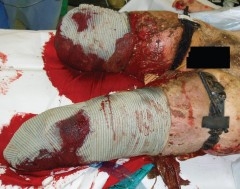Un garrot: Oui mais surtout un garrot pneumatique
26/07/2011
Un travail d'une portée majeure qui met en évidence l'importance de disposer de garrot pneumatique delfi dès que possible.
Les garrots du type du SOFTT ou du CAT doivent être posé à l'avant mais surtout doivent être doublé, associé à un pansement compressif et surtout remplacé le plus tôt possible par un garrot pneumatique du type du garrot DELFI EMT.
--------------------------
An Evaluation of Two Tourniquet Systems for the Control of Prehospital Lower Limb Hemorrhage.
Taylor DM et all. (J Trauma. 2011;XX: 000–000) DOI: 10.1097/TA.0b013e31820e0e41
Background:
Hemorrhage remains the main cause of preventable death on the modern battlefield. As Improvised Explosive Devices in Afghanistan become increasingly powerful, more proximal limb injuries occur. Significant concerns now exist about the ability of the windlass tourniquet to control distal hemorrhage after mid-thigh application. To evaluate the efficacy of the Combat Application Tourniquet (CAT) windlass tourniquet in comparison to the newer Emergency and Military Tourniquet (EMT) pneumatic tourniquet.
Methods:
Serving soldiers were recruited from a military orthopedic outpatient clinic. Participants’ demographics, blood pressure, and body mass index were recorded. Doppler ultrasound was used to identify the popliteal pulses bilaterally. The CAT was randomly self-applied by the participant at midthigh level, and the presence or absence of the popliteal pulse on Doppler was recorded. The process was repeated on the contralateral leg with the CAT now applied by a trained researcher. Finally, the EMT tourniquet was applied to the first leg and popliteal pulse change Doppler recorded again.
Results:
A total of 25 patients were recruited with 1 participant excluded. The self-applied CAT occluded popliteal flow in only four subjects (16.6%). The CAT applied by a researcher occluded popliteal flow in two subjects (8.3%). The EMT prevented all popliteal flow in 18 subjects (75%). This was a statistically significant difference at p 0.001 for CAT versus EMT.
Conclusion:
This study demonstrates that the CAT tourniquet is ineffective in controlling arterial blood flow when applied at mid-thigh level. The EMT was successful in a significantly larger number of participants.



Les commentaires sont fermés.